Lemon quartz is a captivating variety of quartz that has gained popularity in recent years for its vibrant yellow hue and its use in jewelry and decorative items.
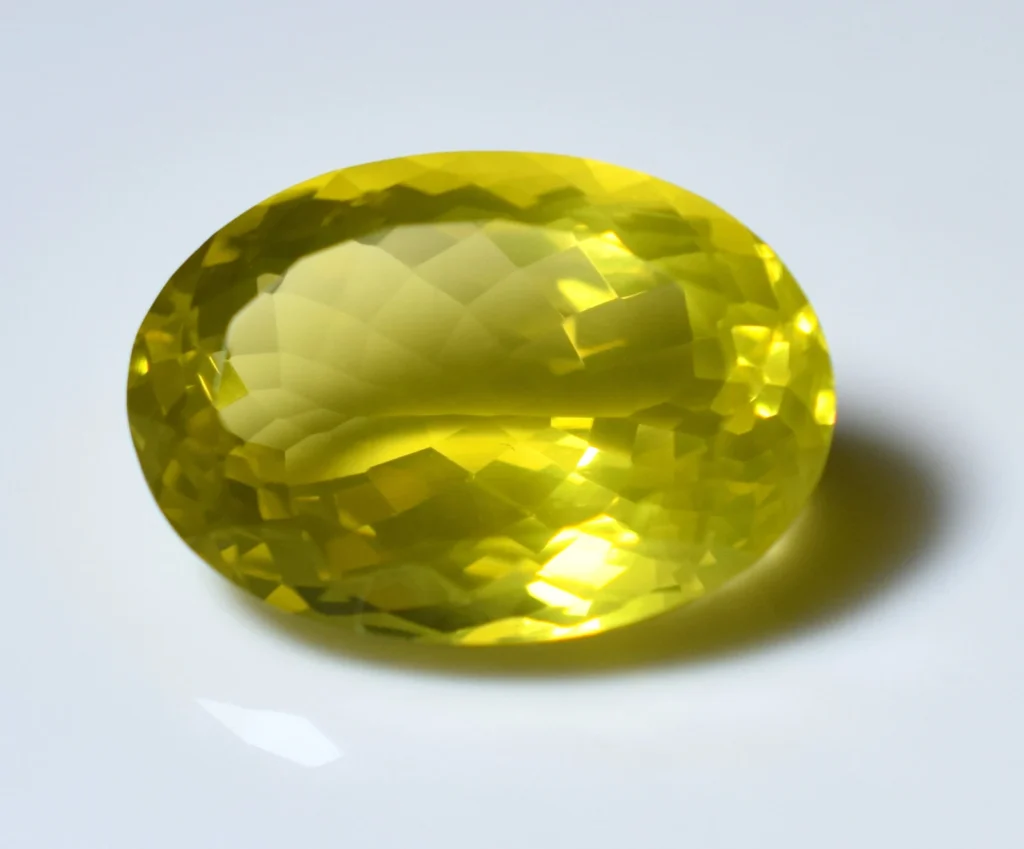
Lemon quartz, also known as “oro verde quartz,” is a type of transparent quartz that has been treated to achieve its distinctive lemon-yellow color. The color is typically created through a heat treatment process involving iron-rich minerals or through irradiation followed by heat. Lemon quartz is prized for its bright, sunny color which can range from pale yellow to a rich, golden shade.
The characteristics of lemon quartz include:
- Color: Ranges from light yellow to deep golden.
- Clarity: Typically very clear with few inclusions.
- Luster: Exhibits a glass-like luster typical of quartz.
- Hardness: Like all quartz, it has a hardness of 7 on the Mohs scale, making it quite durable and suitable for various types of jewelry.
- Cut: Often cut into traditional shapes like rounds, ovals, and cushions, as well as more intricate designer cuts to enhance its brilliance and color.
How Lemon Quartz Differs from Other Quartz Varieties
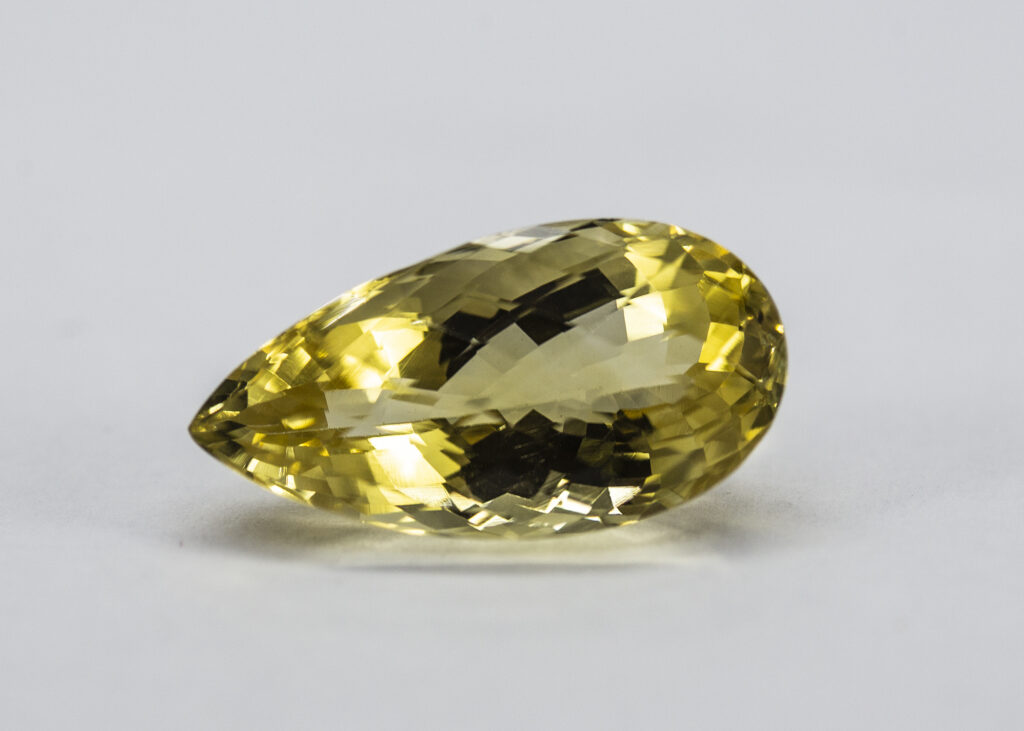
Lemon quartz is distinct from other quartz varieties primarily due to its color treatment and resulting appearance. Here are some ways it differs from other members of the quartz family:
- Color Treatment: Unlike naturally colored quartz like amethyst or citrine, lemon quartz’s color is usually the result of artificial treatment, making it unique among quartz varieties that are valued for their natural color.
- Color Range: While citrine also exhibits a yellow hue, lemon quartz typically presents a brighter, more vivid yellow. This makes it stand out compared to the more subdued, earthy tones of natural citrine.
- Usage: Because of its vibrant color, lemon quartz is often used in large statement pieces of jewelry, which is less common with other quartz varieties like smoky quartz or rose quartz.
Lemon quartz offers a cheerful and bright option in the quartz family, appealing to those looking for a durable and attractively colored gemstone. Its uniqueness lies in the methods used to achieve its color, setting it apart from its naturally colored counterparts.
Geological Formation and Sources of Lemon Quartz
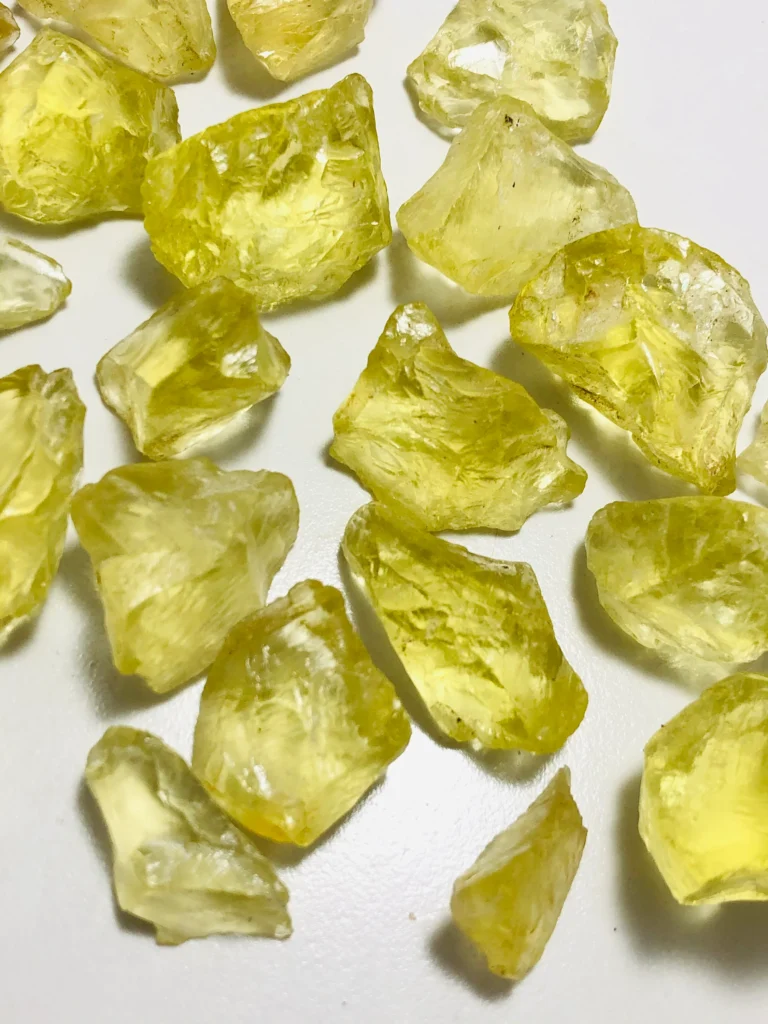
Lemon quartz, like other varieties of quartz, is primarily formed through hydrothermal processes or pegmatites. Its specific color, however, is usually the result of human intervention, typically through heat treatment or irradiation of other types of quartz. Below, we explore the geological formation of quartz and then discuss the primary sources where quartz used to create lemon quartz is mined.
Geological Formation of Quartz
Quartz is one of the most common and abundant minerals in the Earth’s crust, primarily formed in two key environments:
- Hydrothermal Veins: Quartz forms in hydrothermal veins when silica-rich solutions, typically derived from the deeper regions of the crust, ascend through the rock layers. As these solutions cool and the pressure decreases, quartz crystals precipitate out of the solution and grow within the cavities of the rocks.
- Pegmatites: These are igneous rocks formed during the final stages of magma crystallization. Pegmatites can contain large crystals, including quartz, due to the high water content that allows crystals to grow rapidly.
For lemon quartz specifically, natural quartz crystals that are clear and have the right type and amount of impurities are selected and then subjected to treatments to achieve the desired lemon color.
Primary Mining Locations
While lemon quartz itself does not naturally occur and is created through treatment processes, the original quartz crystals can be sourced from numerous locations worldwide. Here are some primary regions known for their significant quartz deposits:
- Brazil: One of the largest producers of quartz in the world, Brazil has extensive deposits of clear quartz that are ideal for transformation into lemon quartz.
- Madagascar: Known for its rich mineral resources, Madagascar provides a variety of quartz that can be treated to create lemon quartz.
- United States: The U.S. has several significant quartz mining locations, including Arkansas, known as the “Quartz Crystal Capital of the World,” where large, clear crystals are abundant.
- Russia and the Alps in Europe: Both regions are known for their natural quartz deposits, which serve as a source for high-quality crystals used in the production of treated quartz varieties like lemon quartz.
Though the primary quartz crystals can come from these and other global sources, the actual process of converting them into lemon quartz generally takes place in specialized facilities where the stones can be carefully treated to achieve their distinctive yellow color. This process not only enhances the beauty of the quartz but also adds value to it as a gemstone in the jewelry industry.
Physical and Chemical Properties of Lemon Quartz
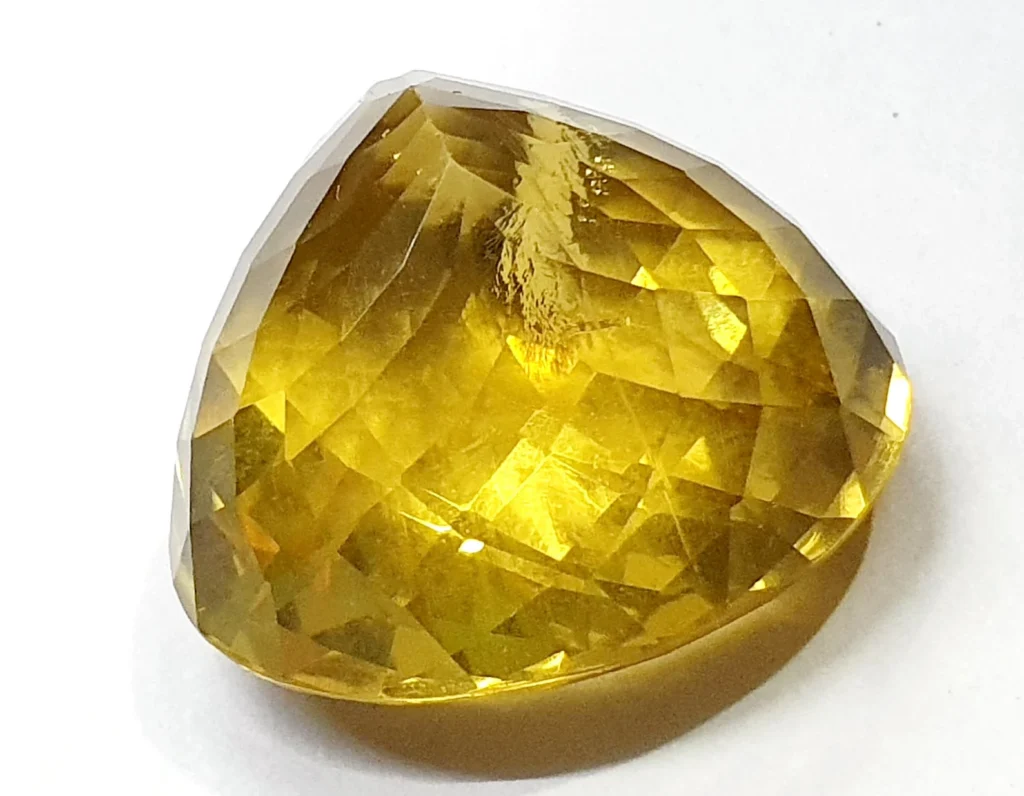
Lemon quartz shares many of the physical and chemical properties of natural quartz, given that it is essentially treated natural quartz. Below, we detail these properties, highlighting aspects relevant to lemon quartz:
Chemical Properties
- Chemical Composition: Lemon quartz is primarily silicon dioxide (SiO2). This composition is typical of all quartz varieties.
- Color Origins: The lemon yellow color of lemon quartz is typically induced by gamma-ray irradiation followed by heat treatment. These processes alter the physical environment around aluminum impurities within the quartz, often in the presence of lithium, leading to color centers that produce the distinctive yellow hue.
- Stability: Quartz is chemically inert and stable under most environmental conditions, which makes lemon quartz resistant to chemicals that might otherwise damage or alter its appearance.
Physical Properties
- Hardness: Quartz ranks 7 on the Mohs hardness scale, making lemon quartz relatively durable and scratch-resistant, suitable for everyday wear.
- Cleavage: Quartz has no cleavage, which means it does not break along defined planes. This property makes lemon quartz less likely to chip or crack, enhancing its durability.
- Fracture: Quartz typically fractures in a conchoidal (shell-like) manner, which is important for gem cutters to consider when shaping the stones.
- Specific Gravity: Typically, quartz has a specific gravity of about 2.65, which is considered average for minerals of its size and type.
- Refractive Index: The refractive index of quartz, including lemon quartz, ranges from 1.544 to 1.553, contributing to its brilliance and the way it interacts with light.
- Luster: Quartz has a vitreous (glass-like) luster that contributes to its aesthetic appeal when polished.
Thermal and Optical Properties
- Thermal Stability: Quartz is relatively stable thermally, able to withstand high temperatures without being damaged, up to the point of about 573 degrees Celsius, where it undergoes a reversible transformation in crystal structure.
- Optical Properties: Quartz is often doubly refractive, meaning it can split a single light ray into two rays, a property that can enhance the visual depth and brilliance of lemon quartz when cut and polished appropriately.
These properties make lemon quartz a versatile and attractive option for various uses, particularly in jewelry, where its durability, unique color, and beautiful luster are highly prized. The treatment processes that give lemon quartz its color do not significantly alter these inherent physical and chemical characteristics, ensuring that it retains the qualities that make quartz such a popular and enduring gemstone.
Uses and Applications of Lemon Quartz
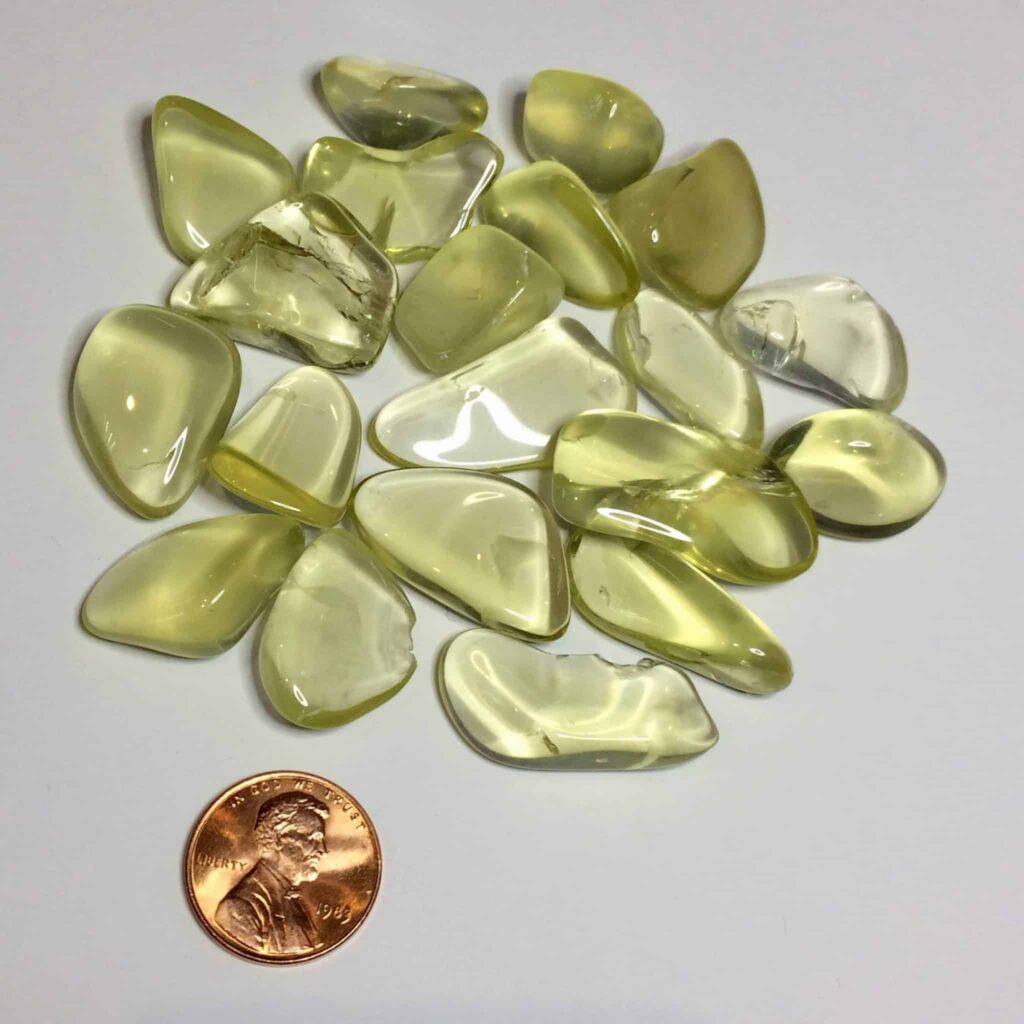
Lemon quartz, with its vibrant yellow hue and durable properties, finds a variety of uses across different fields, particularly in jewelry and decorative arts. Here’s a detailed look at the main uses and applications of this striking gemstone:
Jewelry Making
- Rings and Pendants: Lemon quartz is popularly used in rings and pendants due to its bright color and clarity. Its hardness makes it suitable for daily wear.
- Earrings and Bracelets: The stone’s resistance to wear and tear also makes it an excellent choice for earrings and bracelets, which can be subject to frequent movement and potential impacts.
- Designer Jewelry: Lemon quartz is often used by designers looking to create unique, eye-catching pieces. Its vivid color can be a centerpiece or a complementary stone in multi-gem jewelry designs.
Decorative Arts
- Carvings: Due to its good hardness and lack of cleavage, lemon quartz can be intricately carved into various decorative items, such as sculptures, figurines, and ornamental objects.
- Home Decor: Large crystals of lemon quartz, either raw or polished, are sometimes used as decorative pieces in homes and offices. They can serve as attractive focal points in interior design.
Healing and Metaphysical Uses
- Crystal Therapy: Lemon quartz is sometimes used in crystal healing therapies. It is believed to have properties that help clear the mind, reduce anxiety, and foster communication.
- Meditation: Some practitioners use lemon quartz in meditation, claiming it aids concentration and helps to align thoughts and emotions.

Collecting
- Mineral Collections: As with other quartz varieties, lemon quartz is often included in mineral collections. Collectors may seek out particularly clear or beautifully cut specimens.
Fashion and Design
- Fashion Accessories: Beyond traditional jewelry, lemon quartz is used in making brooches, hair accessories, and other fashion details that benefit from a splash of color.
- Art and Craft Projects: Artists and crafters use small pieces of lemon quartz for mosaic projects or as embellishments in mixed media art.
Technology (Less Common)
- Quartz Watches: While lemon quartz itself is not used in watchmaking, its base material, quartz, plays a crucial role due to its piezoelectric properties, which are essential for maintaining the timekeeping in quartz watches.
Lemon quartz is appreciated not only for its beauty but also for its versatility, making it a sought-after material in many creative and decorative contexts. Its blend of visual appeal and physical durability ensures that it remains a popular choice for a wide range of applications.




































